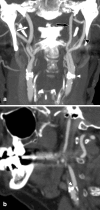Symptomatic carotid near-occlusion causes a high risk of recurrent ipsilateral ischemic stroke
- PMID: 31701329
- PMCID: PMC6989616
- DOI: 10.1007/s00415-019-09605-5
Symptomatic carotid near-occlusion causes a high risk of recurrent ipsilateral ischemic stroke
Abstract
Objective: To assess the risk of recurrent ipsilateral ischemic stroke in patients with symptomatic near-occlusion with and without full collapse.
Methods: Included were consecutive patients eligible for revascularization, grouped into symptomatic conventional ≥ 50% carotid stenosis (n = 266), near-occlusion without full collapse (n = 57) and near-occlusion with full collapse (n = 42). The risk of preoperative recurrent ipsilateral ischemic stroke was analyzed, or, for cases not revascularized within 90 days, 90-day risk was analyzed.
Results: The risk of a preoperative recurrent ipsilateral ischemic stroke or ipsilateral retinal artery occlusion was 15% (95% CI 9-20%) for conventional ≥ 50% stenosis, 22% (95% CI 6-38%) among near-occlusion without full collapse and 30% (95% CI 16-44%) among near-occlusion with full collapse (p = 0.01, log rank test). In multivariate analysis, near-occlusion with full collapse had a higher risk of recurrent ipsilateral ischemic stroke (adjusted HR 2.6, 95% CI 1.3-5.3) and near-occlusion without full collapse tended to have a higher risk (adjusted HR 2.0, 95% CI 0.9-4.5) than conventional ≥ 50% stenosis. Only 24% of near-occlusion with full collapse underwent revascularization, common causes for abstaining were misdiagnosis as occlusion (31%), deemed surgically unfeasible (21%) and low perceived benefit (10%).
Conclusions: Symptomatic carotid near-occlusion has a high short-term risk of recurrent ipsilateral ischemic stroke, especially near-occlusion with full collapse.
Keywords: Carotid stenosis; Large vessel disease; Neurology; Stroke.
Conflict of interest statement
The authors declare that they have no conflict of interest.
Figures



Comment in
-
Comment on the article "Symptomatic carotid near-occlusion causes a high risk of recurrent ipsilateral ischemic stroke" by Gu et al.J Neurol. 2020 Mar;267(3):849-851. doi: 10.1007/s00415-019-09669-3. Epub 2019 Dec 14. J Neurol. 2020. PMID: 31838712 No abstract available.
Similar articles
-
Symptomatic carotid near-occlusion with full collapse might cause a very high risk of stroke.J Intern Med. 2015 May;277(5):615-23. doi: 10.1111/joim.12318. Epub 2014 Nov 13. J Intern Med. 2015. PMID: 25297638
-
Early risk of recurrent stroke in patients with symptomatic carotid near-occlusion: Results from CAOS, a multicenter registry study.Int J Stroke. 2017 Oct;12(7):713-719. doi: 10.1177/1747493017714177. Epub 2017 Jun 8. Int J Stroke. 2017. PMID: 28592219
-
The risk of recurrent stroke at 24 months in patients with symptomatic carotid near-occlusion: results from CAOS, a multicentre registry study.Eur J Neurol. 2019 Nov;26(11):1391-1398. doi: 10.1111/ene.14006. Epub 2019 Jun 17. Eur J Neurol. 2019. PMID: 31126001
-
Near-Occlusion is a Common Variant of Carotid Stenosis: Study and Systematic Review.Can J Neurol Sci. 2022 Jan;49(1):55-61. doi: 10.1017/cjn.2021.50. Epub 2021 May 14. Can J Neurol Sci. 2022. PMID: 33988097
-
Ultrasound surveillance after CAS and CEA: what's the evidence?J Cardiovasc Surg (Torino). 2014 Apr;55(2 Suppl 1):33-41. J Cardiovasc Surg (Torino). 2014. PMID: 24796896 Review.
Cited by
-
Mapping Cerebrovascular Reactivity Impairment in Patients With Symptomatic Unilateral Carotid Artery Disease.J Am Heart Assoc. 2021 Jun 15;10(12):e020792. doi: 10.1161/JAHA.121.020792. Epub 2021 Jun 9. J Am Heart Assoc. 2021. PMID: 34102856 Free PMC article.
-
Diagnostic separation of conventional ⩾50% carotid stenosis and near-occlusion with phase-contrast MRI.Eur Stroke J. 2024 Mar;9(1):135-143. doi: 10.1177/23969873231215634. Epub 2023 Nov 30. Eur Stroke J. 2024. PMID: 38032058 Free PMC article.
-
Carotid near-occlusion is often overlooked when CT angiography is assessed in routine practice.Eur Radiol. 2020 May;30(5):2543-2551. doi: 10.1007/s00330-019-06636-4. Epub 2020 Jan 31. Eur Radiol. 2020. PMID: 32006173 Free PMC article.
-
The pitfalls and challenges in the diagnosis and treatment of patients with carotid near-occlusion: a narrative review.Quant Imaging Med Surg. 2024 Dec 5;14(12):9600-9619. doi: 10.21037/qims-24-1037. Epub 2024 Nov 18. Quant Imaging Med Surg. 2024. PMID: 39698665 Free PMC article. Review.
-
Near-occlusion is difficult to diagnose with common carotid ultrasound methods.Neuroradiology. 2021 May;63(5):721-730. doi: 10.1007/s00234-021-02687-x. Epub 2021 Mar 13. Neuroradiology. 2021. PMID: 33715027 Free PMC article.
References
MeSH terms
LinkOut - more resources
Full Text Sources
Medical

